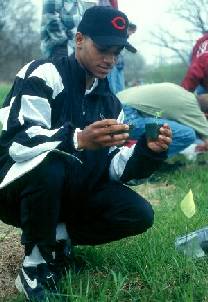ABSTRACT:In this 3-week laboratory, students investigate the effects of an abiotic or biotic ecological factor on the growth or reproduction of rapid-cycling brassica (Brassica rapa L.: Wisconsin Fast Plants) seedlings in the field. Measurable treatments include light, wind, herbivory, chemical or organic fertilizer, insecticides, and growth regulators (i.e., gibberellic acid spray, auxin paste). Students learn how to develop an hypothesis and apply the scientific method in a field setting. Students work in pairs and set up their experiments using previously prepared Wisconsin Fast Plant seedlings. One week later students harvest their plants during a return field trip after which they collect their data, write individual scientific reports, and present their findings in-class. This experiment is unique because Wisconsin Fast Plants are used in a field experiment instead of the usual laboratory setting. CLASS TIME:This experiment is done during three separate 2- hour lab periods. The week before beginning the experiment, a 20-30 minute lecture is desirable to introduce and discuss the scientific method, hypothesis formation, and factors that affect seedling growth. Digital photos and/or a video of the study site may also be presented for visual learners. The students should arrive at the field site with a hypothesis to test and an understanding of the scientific method. Week 1 is used to introduce the study site, equipment, and set up the experiment in the field (i.e., take first measurements on plants). Week 2 is used to complete the experiment (i.e., take final measurements on plants). Week 3 is for in-class oral presentations. OUTSIDE OF CLASS TIME:Each pair of students will need to meet the week prior to experimentation, yet following the introductory discussion/lecture, to develop their hypothesis. Each student will need one week to write an individual scientific paper after the final measurements are collected. Each student analyses/summarizes data separately, writes a scientific paper, and prepares a 5 minute oral summary for an in-class presentation. Conversely, each student could create a poster for an in-class poster session in lieu of an oral and written report. STUDENT PRODUCTS:Each student is assessed on their oral presentation and scientific paper. SETTING:This experiment could be conducted in any setting, preferably with a heterogeneous plant community (i.e., forest and grassland). In addition, this experiment should be conducted in an area where potted Wisconsin Fast plants will be undisturbed during the length of the experiment. This experiment could be conducted in spring, summer or early fall (depends on geographic area) when vegetation is not dormant. COURSE CONTEXT:This experiment is used in a majors, undergraduate, biology class with about 25 students per laboratory section. Students are freshman and sophomores. This laboratory is conducted near the end of the spring term. INSTITUTION:This experiment is used at a 4 year university with 10 - 15 laboratory sections. TRANSFERABILITY:This project could be done in most field settings with a heterogeneous plant community. This experiment is suitable for use in community college and high school biology courses and could be adapted for non-majors and upperclassmen by increasing or decreasing the amount of instructor input and preparation. For example, student data could be combined for analyses of larger data sets or a poster session could be used for student assessment in lieu of oral presentations and written reports. AUTHORS:Valerie A. Barko 1,2, Beth A. Burke 2, David J. Gibson 3, and Beth A. Middleton 3,4. |

student experimenting with Wisconsin Fast Plants at a field site, Copyright - Valerie A. Barko,
full size image
|
<top> | |